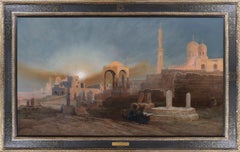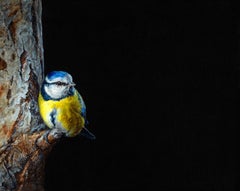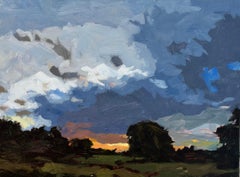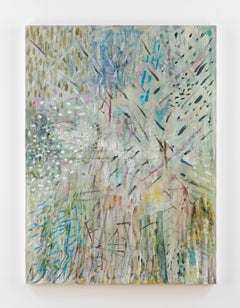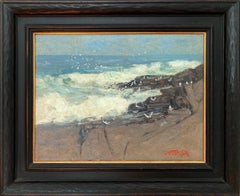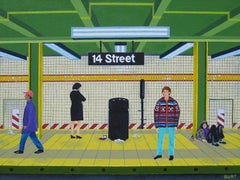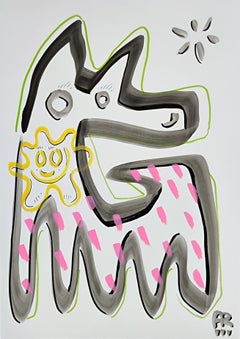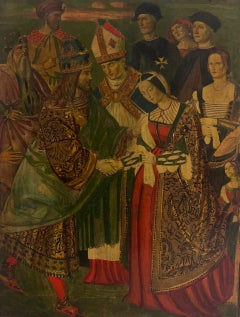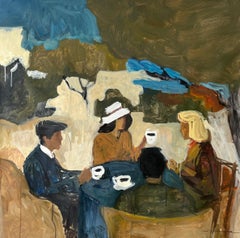Figurative Paintings
2010s Abstract Figurative Paintings
Canvas, Oil
21st Century and Contemporary American Impressionist Figurative Paintings
Canvas, Oil
Artist Comments
Subways are a melting pot of culture. The station on 14th Street offers an ideal setting to observe this diversity and engage in people-watching. On cold days, one can often see homeless alcoholics among the fashion models, Wall Street executives, and commuters from all over Manhattan waiting for trains.Painted with bright colors and in the style of David Hockney and Edward Hopper, the scene depicts artist Leroy Burt's impression of a New York City subway station...
21st Century and Contemporary Pop Art Figurative Paintings
Acrylic
2010s Neo-Expressionist Figurative Paintings
Acrylic, Permanent Marker
Late 19th Century Renaissance Figurative Paintings
Oil
2010s Contemporary Figurative Paintings
Canvas, Acrylic
2010s Contemporary Figurative Paintings
Canvas, Acrylic
21st Century and Contemporary Expressionist Figurative Paintings
Oil, Canvas, Acrylic
2010s Realist Figurative Paintings
Canvas, Oil
2010s Impressionist Figurative Paintings
Canvas, Acrylic
2010s Post-Modern Figurative Paintings
Oil, Acrylic, Permanent Marker
2010s Contemporary Figurative Paintings
Linen, Oil
1990s Contemporary Figurative Paintings
Canvas, Oil
2010s Contemporary Figurative Paintings
Canvas, Acrylic
2010s Abstract Figurative Paintings
Canvas, Oil
Mid-20th Century Old Masters Figurative Paintings
Oil
2010s Abstract Figurative Paintings
Oil, Linen
Late 19th Century Victorian Figurative Paintings
Oil
18th Century Old Masters Figurative Paintings
Oil
2010s Contemporary Figurative Paintings
Canvas, Acrylic
2010s Contemporary Figurative Paintings
Oil, Wood Panel, Resin
2010s Contemporary Figurative Paintings
Oil, Panel
1880s Tonalist Figurative Paintings
Glue, Mixed Media, Oil, Spray Paint, Acrylic
1880s Tonalist Figurative Paintings
Mixed Media, Glue, Oil, Acrylic
Early 19th Century Old Masters Figurative Paintings
Oil
21st Century and Contemporary Contemporary Figurative Paintings
Canvas, Mixed Media, Oil, Acrylic
2010s Contemporary Figurative Paintings
Canvas, Acrylic
1990s Contemporary Figurative Paintings
Oil
21st Century and Contemporary Expressionist Figurative Paintings
Canvas, Acrylic
Early 19th Century English School Figurative Paintings
Oil
Mid-20th Century Expressionist Figurative Paintings
Oil
21st Century and Contemporary Expressionist Figurative Paintings
Canvas, Acrylic
21st Century and Contemporary Contemporary Figurative Paintings
Mixed Media, Acrylic, Panel
21st Century and Contemporary Contemporary Figurative Paintings
Canvas, Mixed Media, Oil, Acrylic
1880s American Impressionist Figurative Paintings
Oil
21st Century and Contemporary Contemporary Figurative Paintings
Mixed Media, Acrylic, Panel
Mid-19th Century Realist Figurative Paintings
Graphite, Chalk
2010s Contemporary Figurative Paintings
Canvas, Acrylic
1950s Figurative Paintings
Canvas, Oil
21st Century and Contemporary Figurative Paintings
Acrylic
Early 17th Century Northern Renaissance Figurative Paintings
Copper
Early 20th Century Modern Figurative Paintings
Tempera
21st Century and Contemporary Contemporary Figurative Paintings
Canvas, Mixed Media, Oil, Acrylic
2010s Realist Figurative Paintings
Wood Panel, Oil
Early 2000s Contemporary Figurative Paintings
Oil
Late 17th Century Baroque Figurative Paintings
Oil, Canvas
21st Century and Contemporary Realist Figurative Paintings
Cotton Canvas, Acrylic
1990s Contemporary Figurative Paintings
Oil
21st Century and Contemporary Abstract Figurative Paintings
Canvas, Oil Pastel, Mixed Media, Acrylic
17th Century Old Masters Figurative Paintings
Oil, Panel
2010s Contemporary Figurative Paintings
Canvas, Oil, Acrylic
Mid-20th Century Post-Impressionist Figurative Paintings
Canvas, Oil
2010s Impressionist Figurative Paintings
Canvas, Acrylic
21st Century and Contemporary Contemporary Figurative Paintings
Canvas, Acrylic
2010s Contemporary Figurative Paintings
Canvas, Acrylic
2010s Contemporary Figurative Paintings
Canvas, Charcoal, Oil, Acrylic
2010s Neo-Expressionist Figurative Paintings
Acrylic, Permanent Marker
21st Century and Contemporary Expressionist Figurative Paintings
Canvas, Acrylic
21st Century and Contemporary Contemporary Figurative Paintings
Canvas, Oil, Acrylic
1810s Victorian Figurative Paintings
Canvas, Oil
Figurative Paintings for Sale
Figurative art, as opposed to abstract art, retains features from the observable world in its representational depictions of subject matter. Most commonly, figurative paintings reference and explore the human body, but they can also include landscapes, architecture, plants and animals — all portrayed with realism.
While the oldest figurative art dates back tens of thousands of years to cave wall paintings, figurative works made from observation became especially prominent in the early Renaissance. Artists like Michelangelo, Leonardo da Vinci and other Renaissance masters created naturalistic representations of their subjects.
Pablo Picasso is lauded for laying the foundation for modern figurative art in the 1920s. Although abstracted, this work held a strong connection to representing people and other subjects. Other famous figurative artists include Francis Bacon and Lucian Freud. Figurative art in the 20th century would span such diverse genres as Expressionism, Pop art and Surrealism.
Today, a number of figural artists — such as Sedrick Huckaby, Daisy Patton and Eileen Cooper — are making art that uses the human body as its subject.
Because figurative art represents subjects from the real world, natural colors are common in these paintings. A piece of figurative art can be an exciting starting point for setting a tone and creating a color palette in a room.
Browse an extensive collection of figurative paintings on 1stDibs.
Read More
See Kent Monkman’s Magical Realist Take on Frontier History
With a solo show at the Denver Art Museum and a commission from the Met, the Cree Canadian painter has become an international sensation.
Cecilia Vicuña Merges Politics, Science and Spirituality in Her Poetic Art
The Chilean creator, who has been living in exile in New York for decades, is having a major moment, receiving the biggest exhibitions, commissions and awards an artist could dream of.
